
Since my last post focused so tightly on the nit-picky aspects of revision (go through and check all the tabs? Scrutinize every semicolon? Really, Anne?), I thought I would let it sink into your brains slowly over a couple of days. Today, however, I’m back and full of vim for editing.
Why so excited? Because today, my friends, I’m going to be walking you through an even nit-pickier type of revision.
Oh, you may laugh, but this time around, I’m going to be challenging you to catch some pretty subtle stuff. (Can’t you feel the excitement burbling through the air?)
I certainly can. Since we concentrate so often here at Author! Author! on problems within a writer’s power to fix — as opposed to larger, less predictable pitfalls that fall outside a submitter’s control, such as whether a particular book category will still be popular a year hence, or if Millicent the agency screener has just burned her lip on a too-hot latte immediately before reading your query — I tend to show negative examples. That’s been especially true in this series on Frankenstein manuscripts, stuffed to the proverbial gills with practical illustrations, so you may learn to spot creeping manuscript illnesses in their natural habitat.
Today, I’m going to turn my usual approach on its head, approach it from another angle, sneak in the back door, and engage in any other euphemism for changing tactics you might happen to name. This time, I’m going to present you with a very good set of opening pages and challenge you to find the subtle problems that might tempt Millicent to change her “Wow!” to “Oh, so close.”
Interestingly, today’s example first came to my attention because of its writer’s doubts about whether she had pulled off a conceptually difficult passage in her work. Those of you who have been following this series may recall reader Christie’s thought-provoking question on a recent post:
You really made me think today, and I thank you, Anne. I have a scene that was bothering me anyway that came to mind when I read your post. My difficulty lies in the fact that the scene involves looking into a rear-view mirror, and I am finding it hard not to resort to all of the visual words associated with looking. I know that I still have too many of them, but it’s hard to know how to change them.
When I printed the pages in question, and read them aloud, I realized how irritating it would be to a reader. I had never considered reading my manuscript aloud until I came upon your blog recently… Any other advice you might offer on the subject would be appreciated.
I love good questions from readers — especially when, like this one, they are so politely phrased. But Christie’s question was unusually hard to answer: as we have seen in recent posts, the answer to how much repetition is too much? varies from book category to book category, as well as from manuscript to manuscript. What works on Writer X’s page 1 will often not work at all on Writer Y’s.
I could, of course, have given my standard answer: when in doubt about what is stylistically acceptable in your chosen book category, rush off to a well-stocked bookstore, start pulling recently-released books akin to yours off shelves, and start reading random pages.
This trick works equally well for writing-based questions ranging from establishing the vocabulary level of your target audience, getting a feel for the expected narrative tone in your subgenre, and determining when, if ever, semicolons may appear in a manuscript. Just make absolutely certain to select pages from many different books, rather than those by your favorite authors, and that any book you consult came out within the last five years. (Longer than that, and you won’t be learning about the current market.)
Since the phenomenon Christie was talking about was unlikely to turn up very often in a well-edited published book, however, this answer, though good advice in itself, seemed a trifle dismissive. So I did what any self-respecting nit-picker would do: I took a look at the pages in question.
Here, by her kind permission, is her opening scene. (If you have trouble reading it, try increasing the size by holding down the COMMAND key while pressing +.)
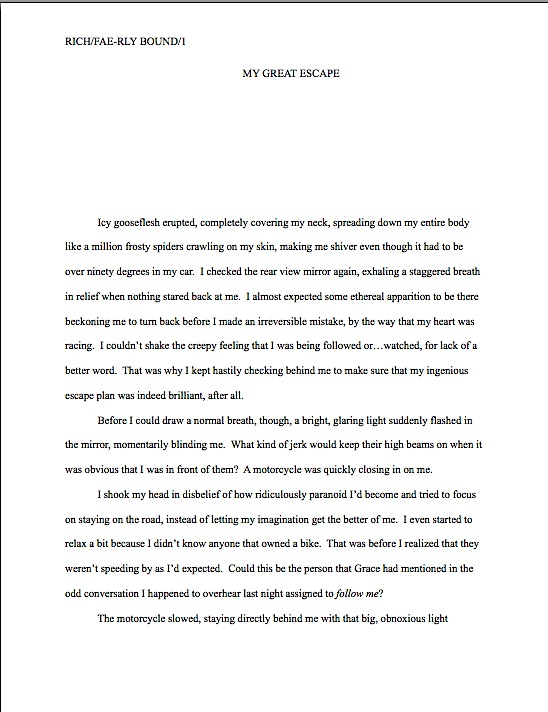
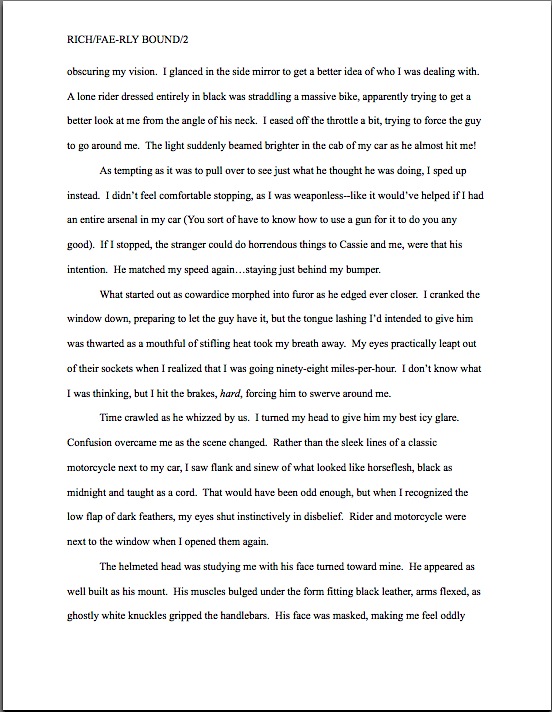
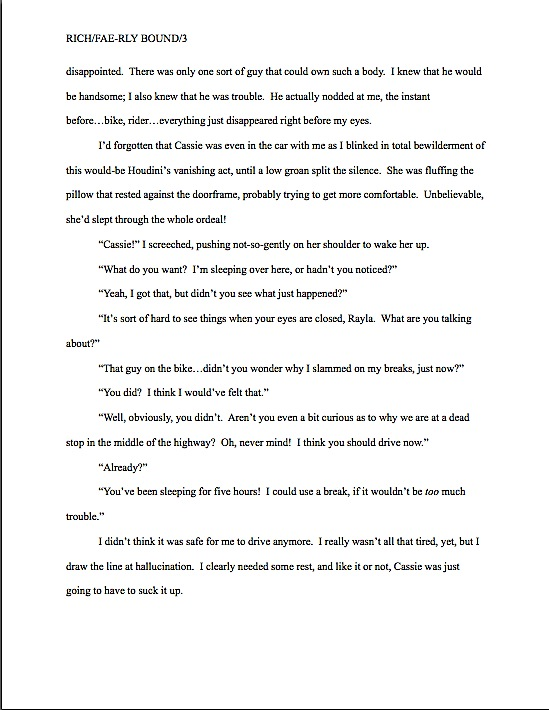
Pretty good grabber, isn’t it? It introduces the characters well, establishes the protagonist as an interesting person in an interesting situation, and tosses the reader smack into the middle of an ongoing conflict, all in a believably chatty first-person narrative voice. This scene is, in short, a good hook for a submission. The closing dialogue is a bit conceptually repetitive, but overall, well done, Christie!
But I come to address her question, not to praise her. So I ask you: are there too many visual references in these pages? If so, which do you think should go?
While you’re pondering those two pertinent issues, allow me to raise another: in which fiction book category would you say, based solely upon these three pages, does this opening belong?
I imagine that each of us will have a slightly different answer to those three questions. Let’s get technical for a moment, to make sure that we’re all concentrating upon the same things. To keep things interesting, let’s apply the same test I’ve been advising for ferreting out any kind of repetition: highlighting every instance of it. Take a gander:
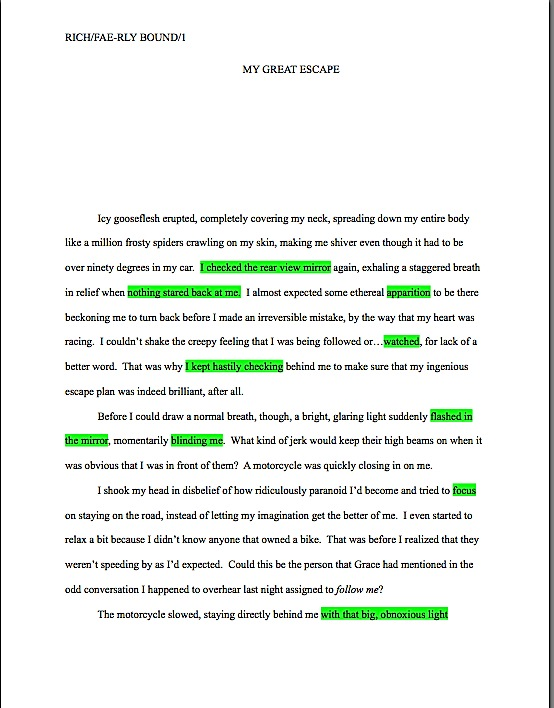
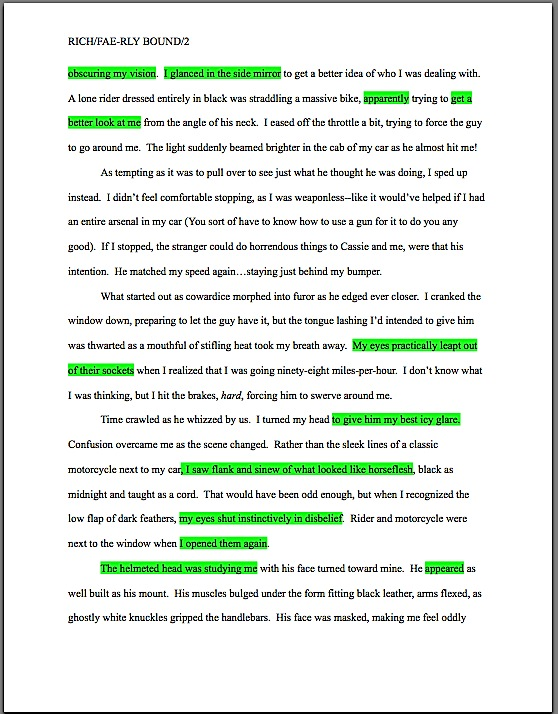
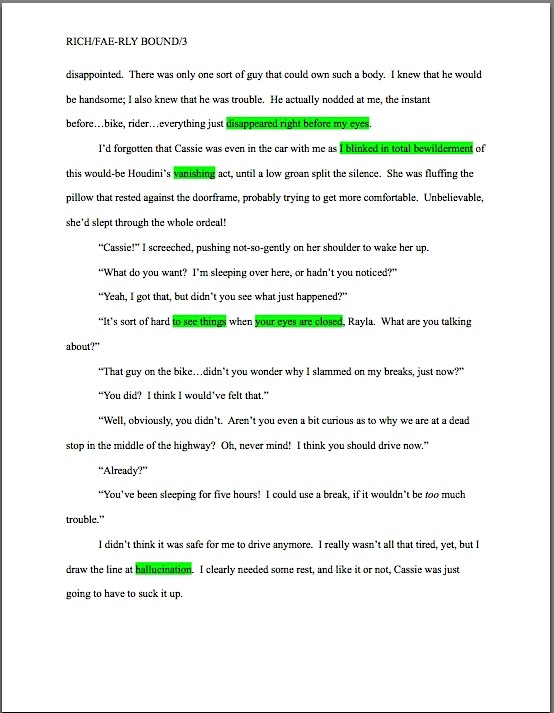
Seems like quite a few more vision-based references now, doesn’t it? To a professional reader, all of those references to sight would have popped out the first time around, without all of the green ink.
And yet compared to most fiction and memoir submissions, these pages actually rely upon vision and visually-based conclusions rather less than most. In fact, it’s hardly an exaggeration to say that in 90% of first pages, no sensations either than sight or sound appear at all.
Happily, Christie has been savvier than that: her opening paragraph is stuffed to the brim with sensual imagery. That choice saves the page, from a reader’s perspective: yes, there is quite a bit of reliance upon sight here, but all of that seeing and appearing (what, you hadn’t regarded that as a vision-based term?) is balanced by observations based upon the narrator’s other senses. (Kudos again — but, nit-picker that I am, I would have liked to see that trend continue for the rest of the scene.)
That’s the answer from the reader’s perspective — but the writer is not the reader, right? So short of running out into the street the moment she finished her most recent revision, grabbing the nearest stranger, and forcing him at knifepoint to read these pages, how might a writer go about trying to answer the just right or too much question herself?
Ah, but we highlighted those visual references for a reason. The real test here is how often those green boxes rear their frog-like little faces: how many are there per page, and do they occur in clusters?
Here, the eye activity is not pervasive, but congregated in certain parts of the text. Guess where it would make the most sense to begin revising?
Is the scratch-scratch-scratch sound I’m hearing an indication that half of you are making furious notes to yourself about what to tackle next in your Frankenstein manuscripts, or has a race of giants suddenly all found its respective tummies itchy?
Some of you are managing to raise your hands while taking notes, I see. “But Anne,” those who are thinking strategically inquire, “while the marked-up pages certainly make clear where the writer might start revising, I’m not quite sure how she might go about it. Should she just proceed from box to box, eliminating as many references to sight as she can?”
Actually, that’s not where I would advise making changes first. Since, as Christie herself points out, quite a few of the sight references are integral to the action, I would first try removing all of the non-essential visual words.
Oh, didn’t those leap out at you? They would have at Millicent.
1. Words and phrases that imply seeing
Remember, many words and phrases can mean different things in different contexts; our exemplar may not have been thinking of some of these words and phrases as visually-based, but the reader may perceive them that way.
For instance, several of the word choices here are visually based, logically speaking: apparition, apparently (as I said, almost everyone overlooks that one, so to speak), em>appeared (ditto), vanishing act (although it is used literally here, it often is not), hallucination. Simply selecting other words would substantially reduce the amount of vision-based description in this narrative voice.
Other candidates for changing the wording: some of the phrases used to describe activities other than seeing. Tried to focus, for example. The narrator is not literally trying to focus upon anything, but within a scene with a lot of visual references, is this really the best way to phrase it?
2. Activities that would require seeing, but use different words
This is a subtle one, so stick with me here: as we have discussed before, most manuscripts rely almost exclusively upon the senses of sight and sound, as if no others existed. We could quibble endlessly about how much the ubiquity of these two senses in narrative prose may be attributed to the rise of television and movies, which can use only sight and sound to make their points.
Writers of books, on the other hand, have more possibilities, and you really should take advantage of them. Why must your protagonist see that field of flowers through her window, for instance, instead of smelling it?
That’s a change that would tend to please a professional reader. A revision far less conducive to Millicent’s happiness would be — and don’t pretend that this hasn’t occurred to you throughout this series — when a writer just seeks out all of the visual words (see, look, regard, etc.) and replaces them with other ways of saying that the protagonist is seeing something.
This is such a common revision tactic for Frankenstein manuscripts (especially, I suspect, in the months after we have been discussing repetition here) that even if the writer intends no such thing, Millicent may well draw the conclusion that someone’s been very busy indeed with the search-and-replace function.
In an opening like this one that contains a lot of visual references, that would be a dangerous conclusion for her to draw. But it’s not at all unlikely: go back and re-read the first ten lines of our example, if you don’t believe me.
They contain 8 visual references, right? Of them, 3 are necessary for the reader to understand what is going on: the protagonist checked the rear view mirror; she felt watched; the lights behind her flashed in the mirror. Another, momentarily blinding me is a reaction to the flashing, and thus probably worth keeping.
The other 4, however, could easily be changed; indeed, we’ve already discussed altering one of them. But what are we to make of the repetition of I checked the rear view mirror (line 3) and I kept hastily checking (line 7)?
I can tell you now what an eye-weary Millicent would make of them. She would either assume that the writing in the rest of the manuscript relied on relatively few verbs (not a fair assessment, given the rest of this scene) or that the writer did a word search, noticed two instances of I looked in the rear-view mirror, and changed them both to I checked the rear-view mirror.
Which, of course, is another way of saying that the protagonist looked at something. And, as you may already have noted, is also word-repetitious.
In order to slay the I looked dragon, it’s not enough just to change specific words. Often, the writer will have to come up with both a different way of phrasing and another means of showing the reader what is going on.
3. Visually-based emotional shorthand
There are also places in the text where vision is invoked as a means of expressing emotion: my eyes practically leapt out of their sockets, to give him my best icy glare, my eyes shut instinctively in disbelief, I blinked in total bewilderment. If these emotions could be expressed other than through eye activity — especially since in context, none of them need be conveyed through the eyes — half of the visual references on page 2 would be gone.
4. Head-hopping and narrative assumptions
Stand well back, because I’m about to trumpet a rule: for a first-person narrative to ring true to the reader, it must adhere to two basic rules: report in the narrative only what the narrator could actually have seen, heard, felt, etc., and don’t make unwarranted guesses about other characters’ motivations, feelings, or thoughts.
So mentioning a visual detail that could only be observed from outside the narrator (his own eyes glazing over, for instance), or saying why another character is doing something is not playing fair. That’s just logical, right? One person cannot say for sure what another is seeing or feeling, any more than he can be absolutely certain that he knows why somebody else does something.
Thus, when a first-person narrator reports that her pursuer was trying to get a better look at me, that’s technically a perspective slip. It may be a correct conclusion, but it is necessarily a conclusion, not a fact. For the same reason, the helmeted head was studying me is our heroine’s best guess of what the person on the motorcycle was doing; she may not be correct about that.
5. Characters who look instead of doing something more interesting
As we discussed earlier in this series, aspiring writers often have characters look, as if the act of looking were to the independent observer particularly fascinating. It isn’t, usually — so why not enliven your text by having all of those lookers do, well, almost anything else?
Christie could cut quite a few of the visual references from this scene in this manner. What if, for example, the thing she fears is following her wasn’t sitting in the back seat with an axe, instead of being bottom-lined as nothing stared back at me? How about if the narrator did or said something in response to being startled, rather than just blinking, as my eyes shut instinctively in disbelief and I opened them again imply?
6. Reminding the reader that the narrator or protagonist is in fact the one observing things.
We’ve already talked about this one, right? Once a first- or tight third-person narrative has established that the reader is being shown only a single perspective, anything that the narrative reports is ASSUMED to be from that character’s perspective. Continually inventing narrative excuses to remind the reader who is seeing what (or, more commonly, to justify including a description) is unnecessary — and, when done in excess, downright annoying to Millicent.
The good news is that this type of reminder can usually be cut in its entirety, with no cost to the text. For instance, removing I glanced in the side mirror to get a better idea of who I was dealing with could be excised from the top of page two without lessening the tension or altering the reader’s perception of the flow of events at all.
Notice anything, campers? Once all six kinds of looking are revised away, not even the hardest-nosed Millicent would carp over the amount of visual references in this scene.
So I ask you again: were there too many in the original text?
For my taste, yes — but not by very much. Since the tension level was consistently high throughout the first two pages (it flags a bit once the conversation starts, since the narrator is no longer conveying panic), I would have kept reading.
But that’s just me; another professional reader might feel differently.
Also, it’s important to remember that even though we are focusing for the sake of discussion upon visual references, they might not strike every Millicent as the potential red flags in this opening. Remember, professional readers are trained VERY closely; not much gets past them. So while Christie has presented us with an unusually clean manuscript, that doesn’t mean that solving the vision problem is necessarily all of the revision she would want to do.
Scratching your head, wondering what else she might try afterward? Let’s take a peek at how Millicent might see these pages, to see if she can help steer us in the right direction. (Speaking of visual criteria, my apologies for these photos; apparently, my studio was invaded by some bright red lights today.)
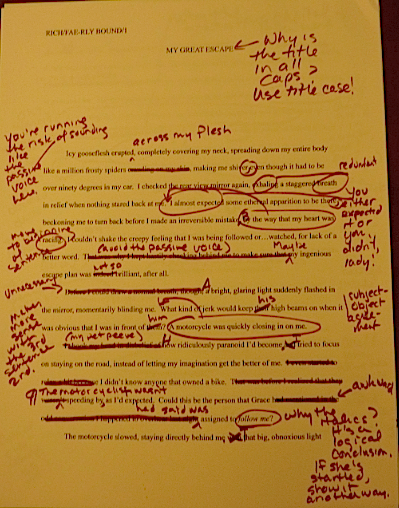
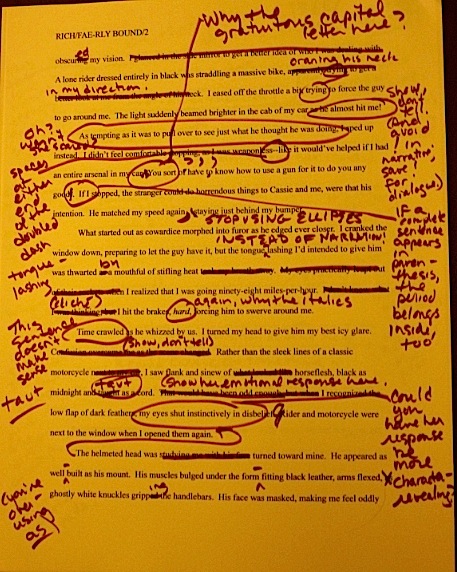
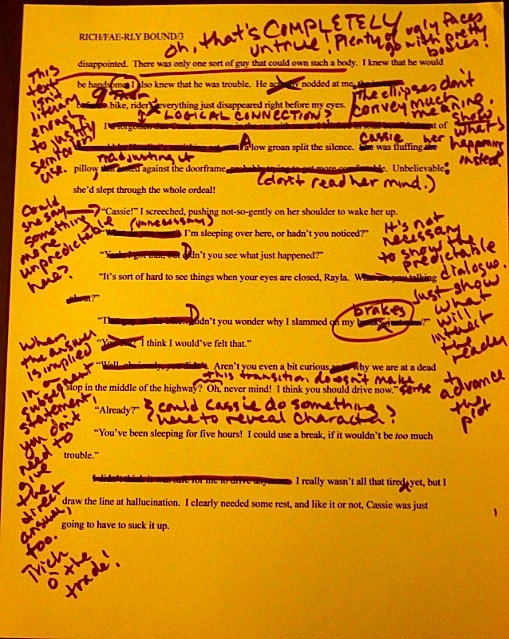
That’s a lot of purple ink, isn’t it, for an opening few pages that we all saw for ourselves were in pretty good shape. And they are in pretty good shape, by submission standards — even if Christie decided to embrace each and every one of Millicent’s suggestions, this is probably only a few hours’ worth of revision. (Don’t strain your eyes, Christie — I’ll send you the marked-up pages.)
That places these pages far, far ahead of the vast majority of what our Millie sees. But that doesn’t mean that they could not use some further revision. In all probability, no individual issue we’ve discussed today would be sufficient to provoke a knee-jerk rejection, but together? Who knows?
Contrary to popular opinion amongst aspiring writers, every professional reader has slightly different tastes in literary style. What virtually all of us share, however, is an affection for nicely-written, well-proofread, grammar-checked, professionally formatted text that tells a good story well.
Which means, in essence, that going over your submission line by line, checking for red flags, is not just likely to increase your chances of pleasing Millicent; it’s her minimum expectation of what a talented writer will do. It’s not as though most manuscripts are rejected based upon a single problem, after all; like formatting problems, writing goof-ups tend to travel in groups.
A high bar to leap? You bet. Lest we forget, Millicent’s standard for comparison is not merely the other submissions that cross her desk on the same day as yours; it’s presentation perfection, solid writing, and a marketable book concept.
That may seem like a gigantic set of goals for as detail-oriented a process as revision, but what you’re doing here is not merely ironing out the rough spots in this manuscript. Working through a really conscientious manuscript revision is going to change the way you write — for the better, if you’ve done your homework. Those old-fashioned schoolteachers who used to make their students write out sample sentences a hundred times had a point, you know — once you’ve devoted a few days to tracking down and examining every single visual reference in a 350-page manuscript, the probability that you’ll have to perform the same search on your next manuscript is rather low.
Trust me on this one. A Frankenstein manuscript can offer a magnificent growth experience for a writer. Like most growth experiences, it’s not much fun in the moment, but the results are ultimately worth it.
Please join me in extending many thanks to Christie for the excellent question and the great example, everybody, and keep up the good work!
Dear Anne,
Your advice is most appreciated. Thank you for tackling this issue. I was surprised by how many things that I didn’t consider, and having your viewpoint is invaluable.
Thanks again,
Christie
Welcome to the “I hadn’t realized/considered” club, Christie. It’s a pretty big one around here, I think. Anne, thanks for the Patriotic and Shakespearean allusions, all within another great post!
You’re entirely welcome, Christie — thanks for providing such a thought-provoking issue!
“Breaks” for “brakes” is a good example of why we should read our manuscripts in hard copy, out loud, in their entirety, as you say, Anne. Spellchecker won’t catch an error that is actually a word.
I do that with “from.” For some reason, my fingers always want to type “form.” I do it at least once a project. It’s so bad I do a search just for that.
I notice that I tend to send messages to myself through mistyped words. When I was writing political platforms (hey, somebody has to do it), my fingers kept misspelling, you guessed it, political; when I was working on my memoir, it was the science in science fiction. But maybe that’s just me.